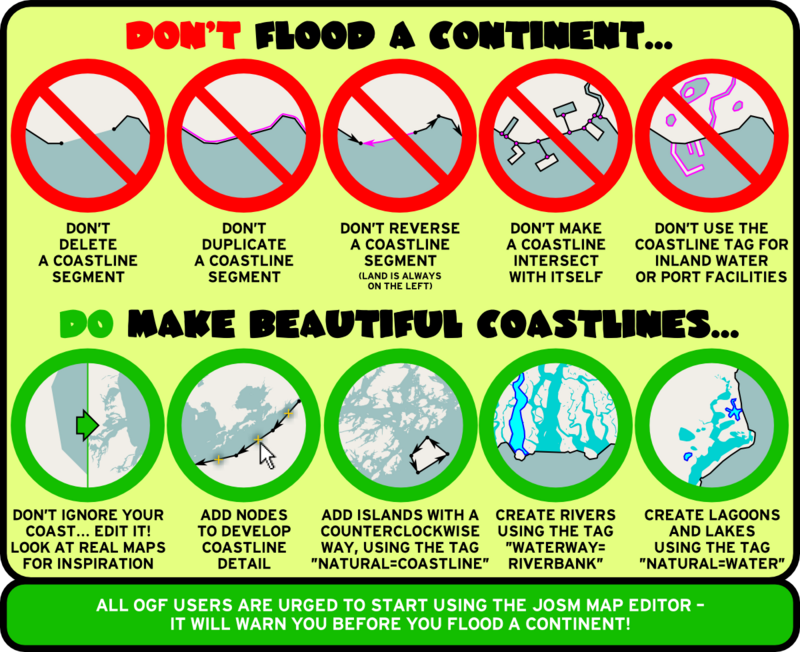OpenGeofiction:Coastline maintenance
Maintaining coastline integrity is important because when there are gaps or mistakes in the coastline, it can create major rendering problems on the map, which look like giant "floods" or "droughts". Everyone should be careful with the natural=coastline tag. Unlike with other tags, please do not just "play with" coastline tags to experiment with "how it might look" - the map renderer handles coastline tags differently.
To protect against disruption the coastline is automatically checked every half hour, and only passed to the renderer if it has no errors. This check is done on each continent in turn, with the last good coastline being used for a continent when it has issues. So, a single coastline error will result in a complete continent not having its coastline updated.
Common issues
The OSM standard does not allow more than 2000 nodes in a coastline way (or any way, for that matter, but it's a problem most commonly seen with coastlines). The solution to the problem is simple - you just "split" the way into two ways, connect end-to-end. This is a single step in JOSM. If you start with a single coastline way, you can select an individual node and then use the "split way" feature (keyboard shortcut "P"). Done!
Coastlines must be in the counter-clockwise direction, with land on the left side of the way.
Large lakes must not be tagged tagged with natural=coastline, instead use natural=water / water=lake, either as a simple closed way or as a multipolygon relation.
Always pay attention to JOSM validation errors and warnings for coastline, addressing them before uploading changes.
Errors
It can be quite difficult, however, to find the exact location of the cause of a "flooding" problem. To help with that, the following useful map overlay has been created, which displays nodes where the coastline is broken in some way:
Loading map...
You can click on a marker in that map to see more information about the related node. A full discussion of how to maintain coastlines can be found on the ![]() openstreetmap wiki. A very short summary is that nodes must be:
openstreetmap wiki. A very short summary is that nodes must be:
- a member of exactly one such way, either as an interior point or as its combined start and end point (if the way is closed) or
- a member of exactly two ways, where it is the start point of one and the end point of the other
- nodes that do not meet this condition are displayed on the coastline_info map. Obviously they don't always cause a rendering problem, but in the case of major flooding you will probably find the problematic location among them.
In the case of a continent flooding, you're all - especially the more experienced users - called upon to try to fix it. Because it is important, it is justified to make an edit in another user's territory if you see a coastline problem.
Continent summary
The following table lists a summary of the coastline condition for each continent. Any error in a continent will prevent the coast being updated for that continent.
The .osm.pbf links can be loaded directly into ![]() JOSM using File/Open Location... if you have the
JOSM using File/Open Location... if you have the ![]() PBF extension installed. Detailed debug from the coastline process is also available.
PBF extension installed. Detailed debug from the coastline process is also available.
| Continent | Status | #Errors | Last update
|
|---|---|---|---|
| ER.osm.pbf / .db | valid | 0 | 2025-12-20 12:33:13 UTC |
| OR.osm.pbf / .db | valid | 0 | 2025-12-20 12:33:16 UTC |
| AR.osm.pbf / .db | valid | 0 | 2025-12-20 12:33:26 UTC |
| BG.osm.pbf / .db | valid | 0 | 2025-12-20 12:33:30 UTC |
| PE.osm.pbf / .db | valid | 0 | 2025-12-20 12:33:34 UTC |
| KA.osm.pbf / .db | valid | 0 | 2025-12-20 12:33:41 UTC |
| UL.osm.pbf / .db | valid | 0 | 2025-12-20 12:34:04 UTC |
| TA.osm.pbf / .db | valid | 0 | 2025-12-20 12:34:17 UTC |
| AN.osm.pbf / .db | valid | 0 | 2025-12-20 12:34:28 UTC |
| world.osm.pbf / .db | valid | 0 | 2025-12-20 12:37:20 UTC |
Map renderer lag
The coastline process runs every half hour. So assuming all is good then it takes at most 40 minutes from making the edit to it being good to render. However, with normal edits a process is run to invalidate the tiles impacted, forcing them to re-render. That invalidation is not run after the updated coastline makes it to the renderer. If you are making other edits in the area, then this isn't really an issue, since those other edits will force the invalidation. But if all you are doing is coastlines then it may take a day or two for the coastline to update.
A Visual Summary
Here is a great graphic that summarizes OGF coastline work.
